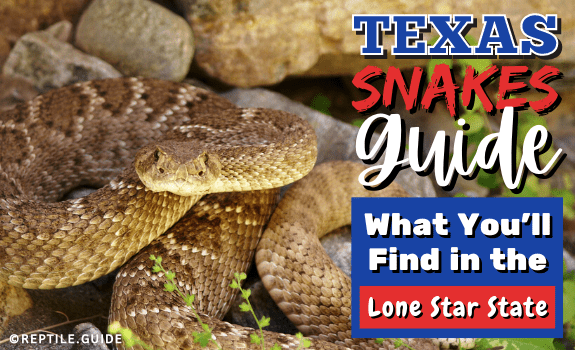Identifying Texas snakes can be overwhelming.
The Lone Star State has the greatest diversity of snakes in the United States.
Over 115 species and subspecies of snakes call Texas home, and only 15% of them are venomous.
Correctly identifying a snake can help you avoid a potentially dangerous situation and safely co-exist with these amazing wild animals.
This guide will help you navigate Texas’s diverse snake population.
We’ll provide you with a list of beneficial resources at the end.
In This Article
Snake Identification Basics
Venomous and nonvenomous species can be challenging to tell apart.
Many harmless species have adaptations that help them look and act like venomous snakes.
Even with our identification tips, you should always exercise caution and leave wildlife alone.
Quickly Identifying Venomous Snakes in Texas
There are four types of venomous snakes in Texas: copperheads, rattlesnakes, cottonmouths, and coral snakes.
They belong to two different families: Vipers and Elapids.
All but one species of venomous snakes in Texas are pit vipers.
Each family has several distinguishing characteristics, which we’ll discuss next.
Pit Vipers
Pit vipers are a subfamily of venomous snakes aptly named for their heat-sensing pits. These sensory pit organs are between the eye and nostril on each side of the head.
The presence of venom glands on each side of the head gives it a triangular shape.
They inject their venom through a single pair of hollow fangs that fold in when not in use.
Another distinguishing feature of pit vipers is their thin, vertical pupils. Nonvenomous snakes have round pupils.
Copperheads
|
Scientific name: |
Agkistrodon contortrix contortrix (Southern copperhead) A.c. laticinctus (Broadbanded copperhead) A.c. pictigaster (Trans-Pecos copperhead) |
|
Range: |
Everywhere except far south Texas. |
|
Size: |
20-30 in. |
|
Description: |
Alternating dark and light reddish-brown bands. Bands sometimes appear in an hourglass shape. Solid brown head. Wide bodies. |
|
Habitat: |
Woodlands, including suburban areas. |
|
Venomous/Non-Venomous: |
Venomous |
The three subspecies of copperheads in Texas have slightly different colorations. All have thick bands alternating from light to dark.
They’re often mistaken for rattlesnakes. Copperheads have thicker bodies and no rattle.
Copperheads are responsible for the highest number of venomous snake bites in the US per year.
Their venom is one of the least toxic in the US.
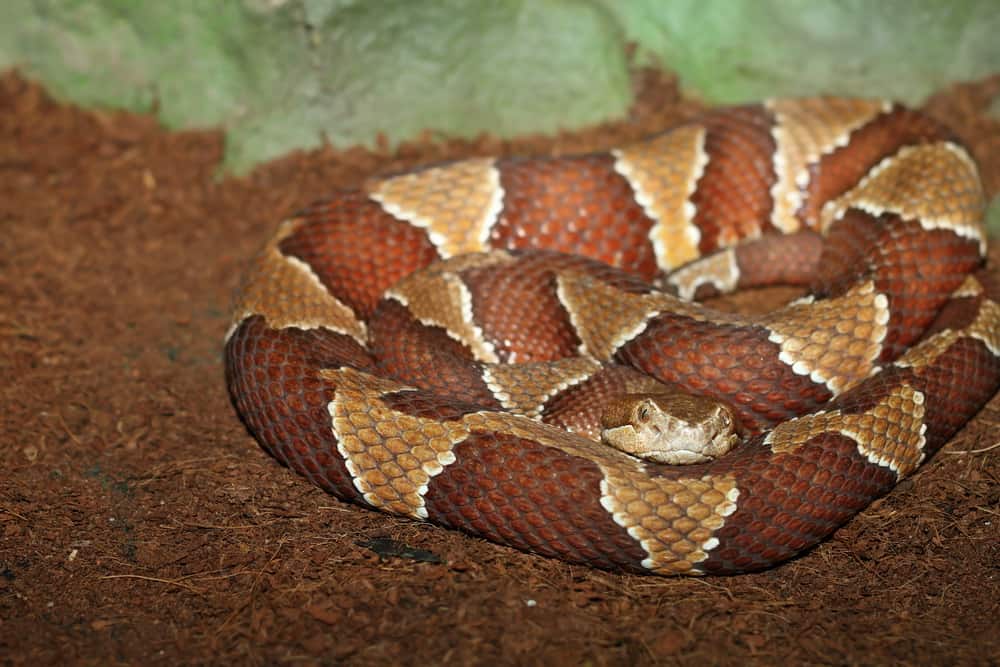
Rattlesnakes
|
Scientific name: |
Subfamily: Crotalinae Crotalus (rattlesnakes) Sistrurus (massasaugas, pygmy rattlesnakes) |
|
Range: |
Throughout Texas |
|
Size: |
Average sizes vary between 24-48 in. The Western diamondback can reach lengths up to 7 ft. |
|
Description: |
Have rattles at the ends of their tails. Variable patterns and coloration. |
|
Habitat: |
A range of habitats, including deserts, grasslands, woodlands, and rocky areas. |
|
Venomous/Non-Venomous: |
Venomous |
When threatened, rattlesnakes vibrate their tails to give off a rattling noise.
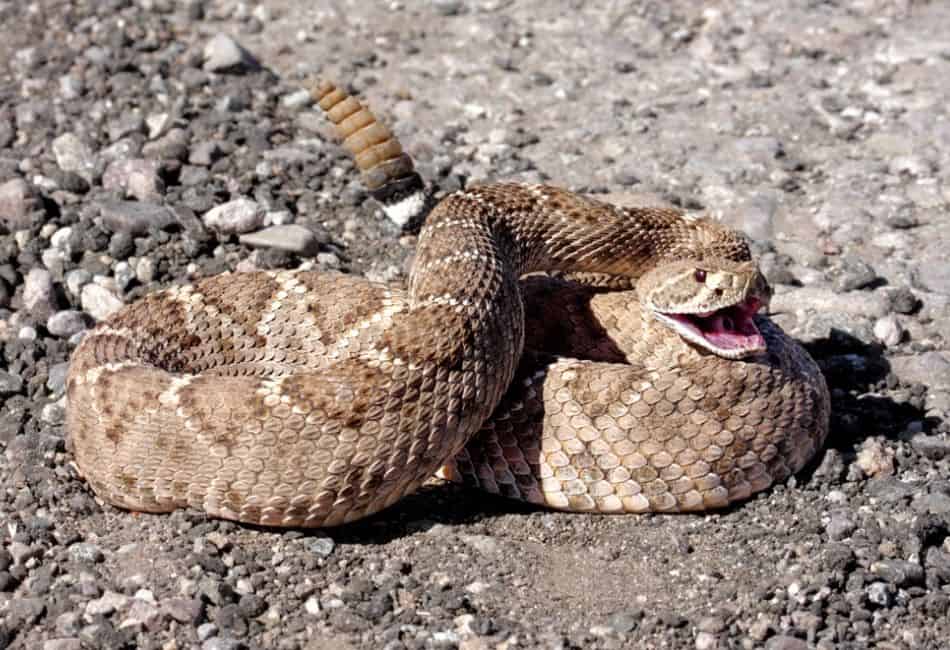
You won’t always hear a rattle.
Certain species have quiet rattles, and sometimes they don’t give a warning sound at all.
Babies are born without rattles. The rattle grows each time a rattlesnake sheds its skin.
They all produce venom, regardless of species or age.
Fun Fact: Most rattlesnake bites occur in Central Texas and the panhandle.
Cottonmouths (Water Moccasins)
|
Scientific name: |
Agkistrodon piscivorus |
|
Range: |
East and Central Texas |
|
Size: |
Average 3.5 ft |
|
Description: |
Dark brown, black or olive-green. Wide, dark bands. Thick-bodied. Triangular heads with narrow necks. |
|
Habitat: |
Found near water. |
|
Venomous/Non-Venomous: |
Venomous |
Cottonmouth coloration and patterns vary.
They darken as they age. Juveniles have more distinct bands, and adults can be nearly solid black.
The tip of a juvenile’s tail is yellow, which they use to attract prey.
Cottonmouths get their name from their warning display. It opens its mouth to reveal a bright-white interior when it feels threatened.
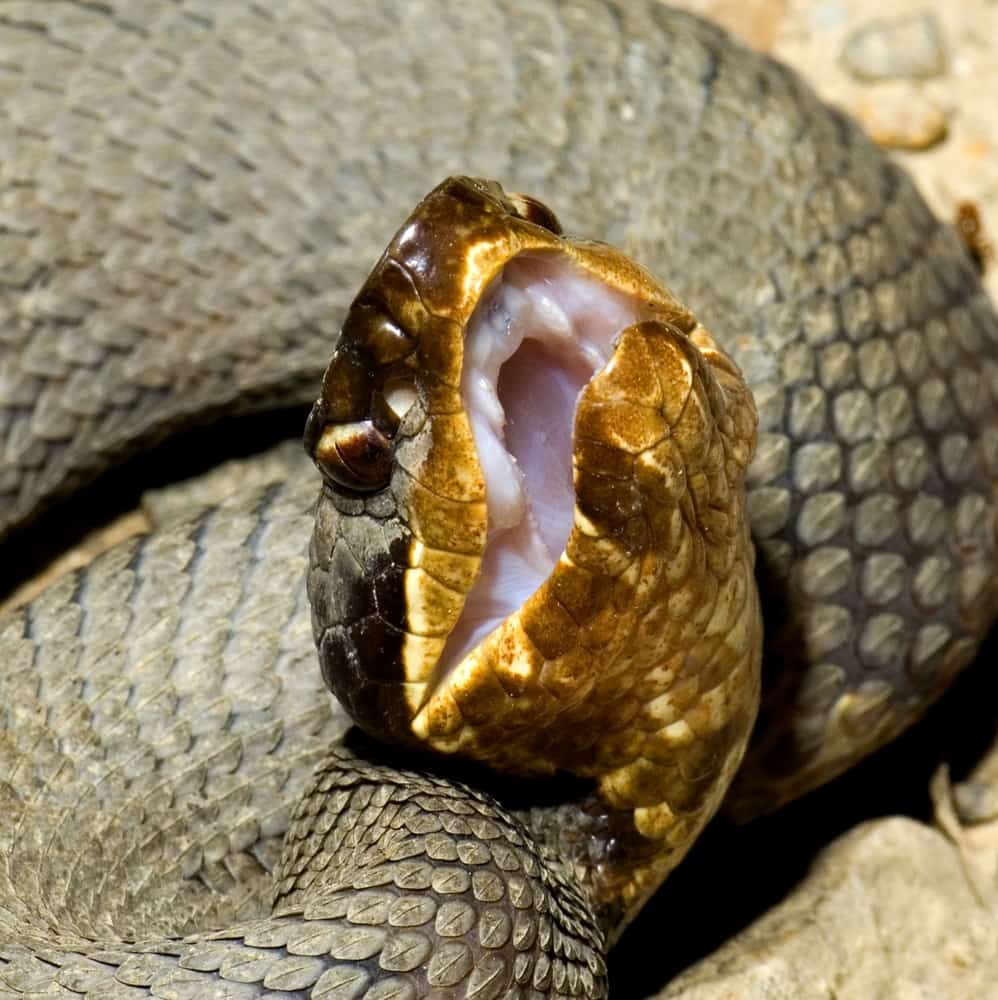
Their other common name, “water moccasin,” comes from their natural habitats.
They’re semi-aquatic and live near swamps, marshes, waterways, lakes, and ponds.
Cottonmouths are often confused with species of nonvenomous black snakes in Texas.
Other Texas water snakes have round pupils, lack sensory pits, and have necks that aren’t distinguishable from their bodies.
Identifying Coral Snakes
The Texas coral snake is the only Elapid native to Texas.
|
Scientific name: |
Micrurus tener |
|
Range: |
Central Texas, South Texas, and East Texas |
|
Size: |
20-30 in. |
|
Description: |
Smooth scales. Rounded head. Round pupils. Black, yellow, and red bands. Yellow bands border red bands. |
|
Habitat: |
A variety of habitats, including woodlands, scrublands, grasslands, and wetlands. |
|
Venomous/Non-Venomous: |
Venomous |
A coral snake’s brightly colored bands are its most distinct identifying trait.
Coral snake look-alikes in Texas include milk snakes (Lampropeltis triangulum) and Texas scarlet snakes (Cemophora lineri).
The easiest way to tell them apart at a glance is by band pattern. Coral snake impersonators have black bands bordering red bands.
But coral snakes have yellow bands bordering red bands.
Notice the pattern difference between the snakes in the following two pictures.
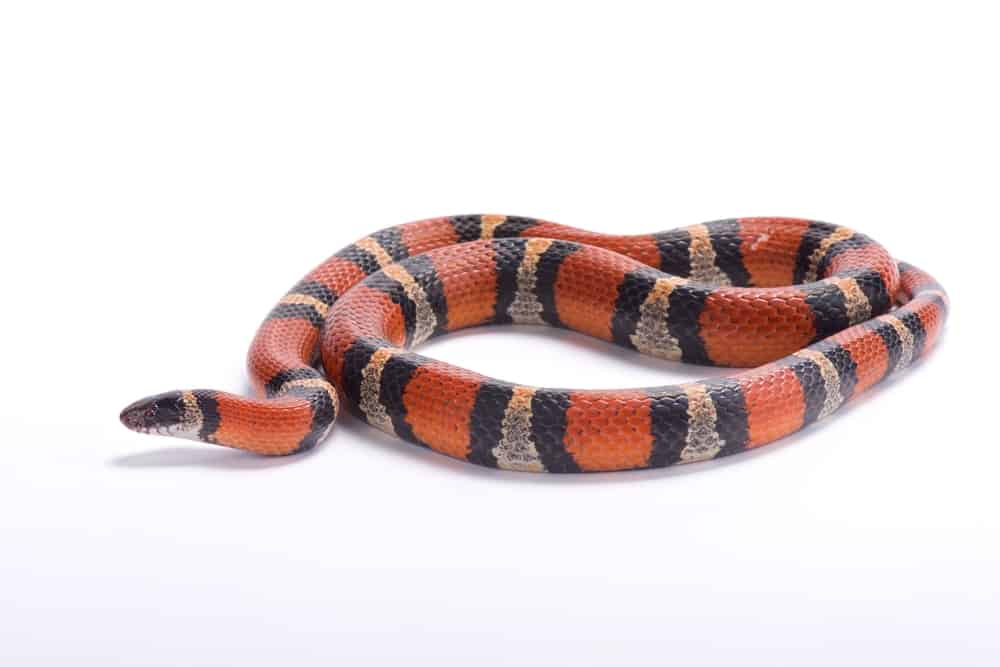

Image credit: u/JohnWesley03 (via Reddit.com)
A popular rhyme to remember which species is venomous goes: “Red to yellow – kill a fellow. Red to black – friend of Jack.”
Unfortunately, this rhyme isn’t always accurate.
It only applies to snakes in the US, and there are some individuals with abnormal patterns that don’t follow the rule.
Never touch a wild snake unless you are 100% sure of its identity.
The Most Venomous Snake in Texas: The Coral Snake
The Texas coral snake is the most venomous species in Texas.
They’re in the Elapidae family, which includes mambas, cobras, and sea snakes.
Coral snakes have short, fixed fangs that don’t move like pit vipers. They release venom by using a chewing motion.
Elapids have neurotoxic venom, meaning it targets the nervous system.
A bite from a coral snake can cause:
- Nausea
- Dizziness
- Loss of muscle control
- Paresthesias (a tingling, pins-and-needles sensation)
- In extreme cases, respiratory distress and paralysis.
Symptoms may not appear for hours after a bite.
You won’t see a Texas coral snake often, and bites are uncommon.
Even though they’re typically nonaggressive, you should take caution if you think you see a coral snake.
Most Common Snakes in Texas
Common snakes in Texas include:
- Coachwhip
- Bull snakes
- Milk snakes
- Copperheads
- Water snakes
- Garter snakes
- Cottonmouths
- Hognose snakes
- Ring-necked snake
- Western diamond-backed rattlesnakes
- Rat snakes (also known as chicken snakes)
- Rough green snakes (also known as grass snakes)
Continue reading for more detailed information on these common snakes!
Non-Venomous Snakes
Non-venomous snakes make up 75% of snakes in the state.
Rat Snakes
|
Scientific name: |
Pantherophis |
|
Range: |
Throughout Texas |
|
Size: |
2-6 ft. |
|
Description: |
Western rat snake: Shiny black, can have dark brown or grey patches. Juveniles have distinct patterns and darken as they age. Great plains rat snake: Grey or tan with brown, tan, or green-grey spots. Stripes on both sides of the head meet at a point between the eyes. Baird’s rat snake: Yellow, bright orange, or salmon-colored, with four darker stripes running from the neck to the tail. Trans-Pecos rat snake: Yellow or tan, with dark brown to black H-shaped markings down its back. |
|
Habitat: |
Grasslands, rocky areas, woodlands, semi-arid regions, agricultural areas. Great climbers, often found in trees. |
|
Venomous/Non-Venomous: |
Non-venomous |

Image credit: u/w_coffey (via Reddit.com)
Water Snakes
|
Scientific name: |
Nerodia |
|
Range: |
Most of Texas, except west Texas |
|
Size: |
16-55 in. |
|
Description: |
Dark vertical lines on lower jaw. Grey, brown, black, or olive. Patterns vary by species. Bands, diamonds, blotches, or solid coloration. |
|
Habitat: |
Semi-aquatic. Near lakes, ponds, marshes, and waterways. |
|
Venomous/Non-Venomous: |
Non-venomous |

Texas Garter Snakes
|
Scientific name: |
Thamnophis |
|
Range: |
Throughout Texas |
|
Size: |
18-48 in. |
|
Description: |
Slender body. Green, brown, or black. Yellow, white, orange, or red stripes from head to tail. |
|
Habitat: |
Deserts, grasslands, and woodlands. Usually near water sources. |
|
Venomous/Non-Venomous: |
Non-venomous |
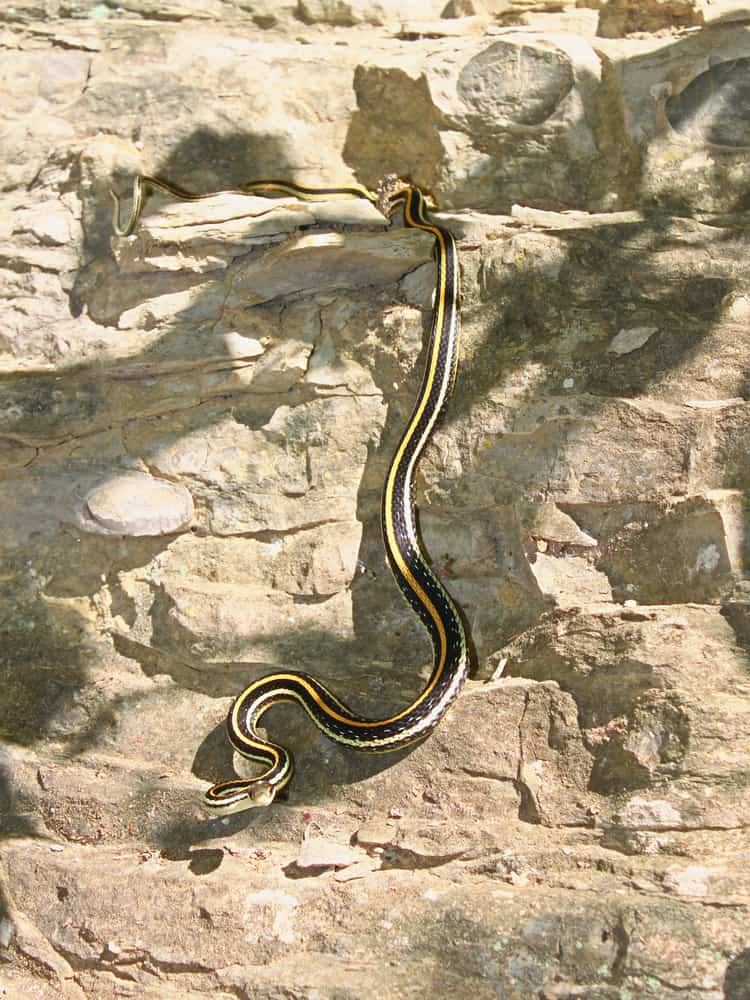
Ring-Necked Snake
|
Scientific name: |
Diadophis punctatus |
|
Range: |
Everywhere except South Texas |
|
Size: |
8-30 in. |
|
Description: |
Grey or olive with a yellow, orange, or cream-colored band around its neck. Bright yellow/orange underside. Smooth scales. |
|
Habitat: |
Grasslands and woodlands. |
|
Venomous/Non-Venomous: |
Non-venomous |
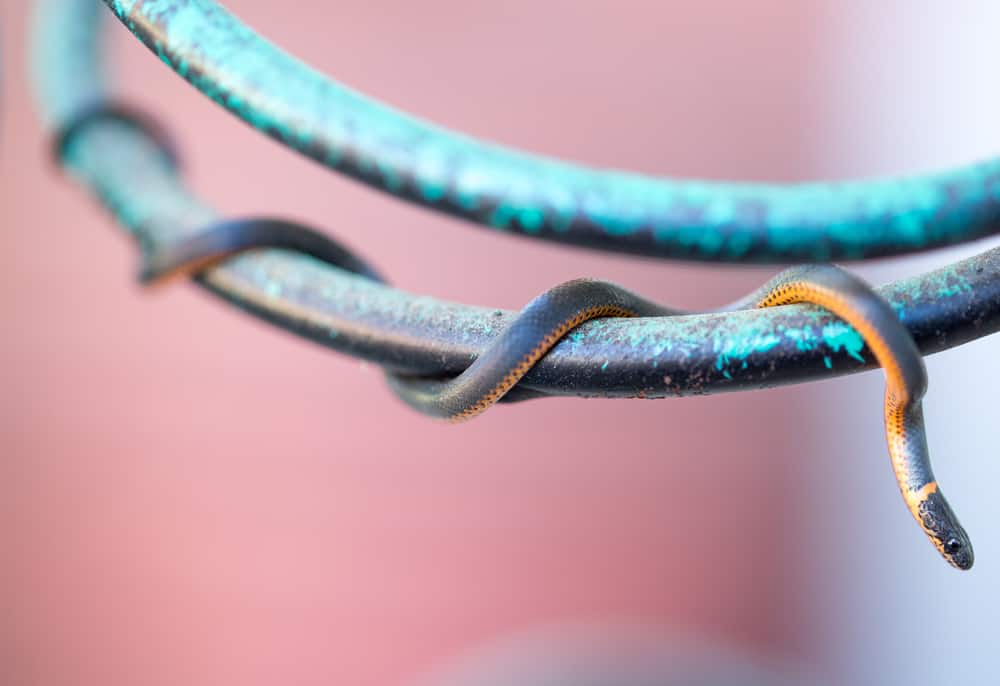
Snakes Native to Texas
Below is a comprehensive list of snakes native to Texas, organized by family.
Colubridae
Most snake species in Texas are in the family Colubridae.
Texas Colubrids include:
- Racers Coluber constrictor
- Mud snake Farancia abacura
- Crayfish snake Regina rigida
- Glossy snakes Arizona elegans
- Indigo snake Drymarchon corais
- Coachwhip Masticophis flagellum
- Salt marsh snake Nerodia clarkii
- Gopher snake Pituophis catenifer
- Flathead snake Tantilla gracilis
- Scarlet snakes Cemophora coccinea
- Corn snakes Pantherophis guttatus
- Texas brown snake Storeria dekayi
- Milk snake Lampropeltis triangulum
- Brazos water snake Nerodia harteri
- Ringneck snakes Diadophis punctatus
- Western worm snake Carphophis vermis
- Common kingsnake Lampropeltis getula
- Banded water snakes Nerodia fasciata
- Rough green snake Opheodrys aestivus
- Plains garter snake Thamnophis radix
- Smooth earth snake Virginia valeriae
- Smooth green snake Opheodrys vernalis
- Baird’s rat snake Pantherophis bairdi
- Western hooknose snake Gyalopion canum
- Black rat snake Pantherophis obsoletus
- Long-nosed snake Rhinocheilus lecontei
- Speckled racer Drymobius margaritiferus
- Western hognose snake Heterodon nasicus
- Schott’s whip snake Masticophis schotti
- Louisiana pine snake Pituophis ruthveni
- Graham’s crayfish snake Regina grahamii
- Common garter snake Thamnophis sirtalis
- Mexican hooknose snake Ficimia streckeri
- Concho water snake Nerodia paucimaculata
- Western ground snake Sonora semiannulata
- Western ribbon snake Thamnophis proximus
- Mexican hognose snake Heterodon kennerlyi
- Diamondback water snake Nerodia rhombifer
- Texas lyre snake Trimorphodon vilkinsonii
- Texas lined snake Tropidoclonion lineatum
- Gray-banded kingsnake Lampropeltis alterna
- Prairie kingsnake Lampropeltis calligaster
- Black-striped snake Coniophanes imperialism
- Eastern hognose snake Heterodon platirhinos
- Chihuahuan/Texas Nightsnake Hypsiglena jani
- Western patchnose snake Salvadora hexalepis
- Red-bellied snake Storeria occipitomaculata
- Big bend blackhead snake Tantilla cucullata
- Blackneck garter snake Thamnophis cyrtopsis
- Checkered garter snake Thamnophis marcianus
- Mountain patchnose snake Salvadora grahamiae
- Mexican black-headed snake Tantilla atriceps
- Plains black-headed snake Tantilla nigriceps
- Trans-Pecos rat snake Bogertophis subocularis
- Central Texas whipsnake Masticophis taeniatus
- Mississippi Green Watersnake Nerodia cyclopion
- Slowinski’s corn snake Pantherophis slowinskii
- Plain-bellied water snake Nerodia erythrogaster
- Northern cat-eyed snake Leptodeira septentrionalis
- Southwestern blackhead snake Tantilla hobartsmithi
Viperidae
- Massasauga Sistrurus catenatus
- Cottonmouth Agkistrodon piscivorus
- Rock rattlesnakes Crotalus lepidus
- Timber rattlesnake Crotalus horridus
- Prairie rattlesnakes Crotalus viridis
- Pygmy rattlesnake Sistrurus miliarius
- Mojave rattlesnake Crotalus scutulatus
- Eastern copperhead Agkistrodon contortrix
- Black-tailed rattlesnake Crotalus molossus
- Western diamondback rattlesnake Crotalus atrox
- Broad-banded copperhead Agkistrodon laticinctus
Leptotyphlopidae
- Blind snakes Leptotyphlops dulcis
- Western blind snake Leptotyphlops humilis
Elapidae
- Texas coral snake Micrurus tener
Protected Species
Protected snake species in the state of Texas:
- Indigo snake
- Speckled racer
- Texas lyre snake
- Timber Rattlesnake
- Brazos water snake
- Texas scarlet snake
- Black striped-snake
- Concho water snake
- Louisiana pine snake
- Northern scarlet snake
- Northern cat-eyed snake
- Big Bend blackhead snake
It’s illegal to kill, harm, handle, or capture these species.
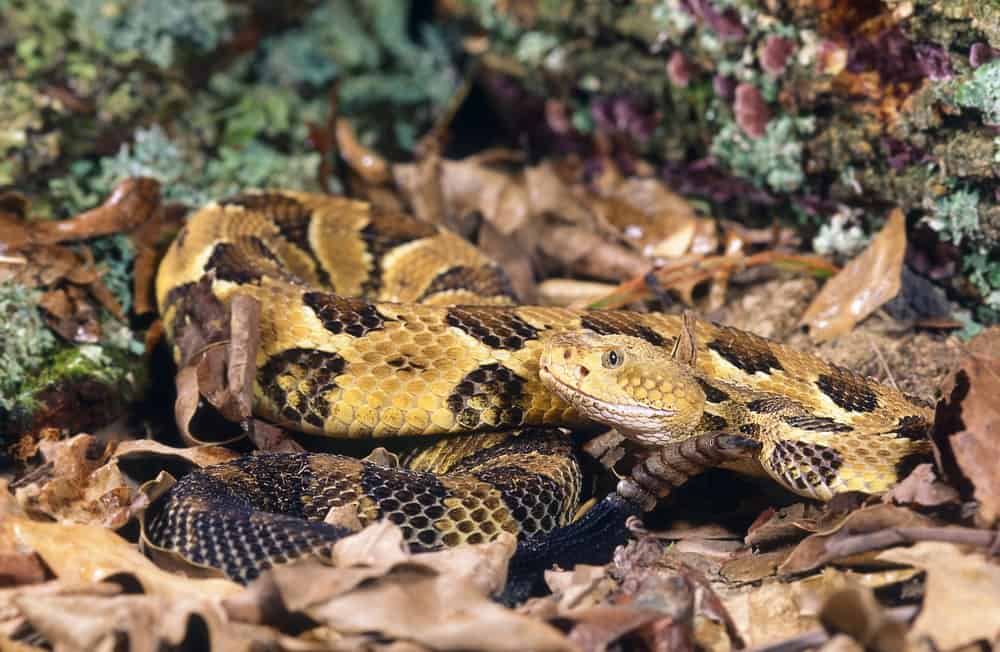
They’re classified as threatened because of habitat destruction and fragmentation, over-harvesting, invasive species, and disease.
What You Need to Know
Stay calm if you see a snake.
They’re more afraid of you than you are of them.
Snakes bite to capture prey or when they feel threatened.
Most bites take place when trying to handle or kill a snake.
Bites also occur when people accidentally step on the snake or someone turns over rocks and logs that it’s hiding under.
Keep your grass short and remove any piles of lumber or debris that snakes (and their prey) might hide under to reduce snakes on your property.
The best thing to do if you see a snake is to leave it alone.
Coexisting With Texas Snakes
Many people are afraid of snakes, but these slithery friends are extremely valuable to keep around.
Snakes play a vital role in the Texas ecosystem.
They help keep rodent and pest populations under control.
A common snake in Texas, the garter snake, is one you want around your home. They eat slugs, insects, amphibians, and mice.
Not only are snakes predators, but also prey. They’re an essential part of the food chain for animals like birds of prey, foxes, and other snakes.
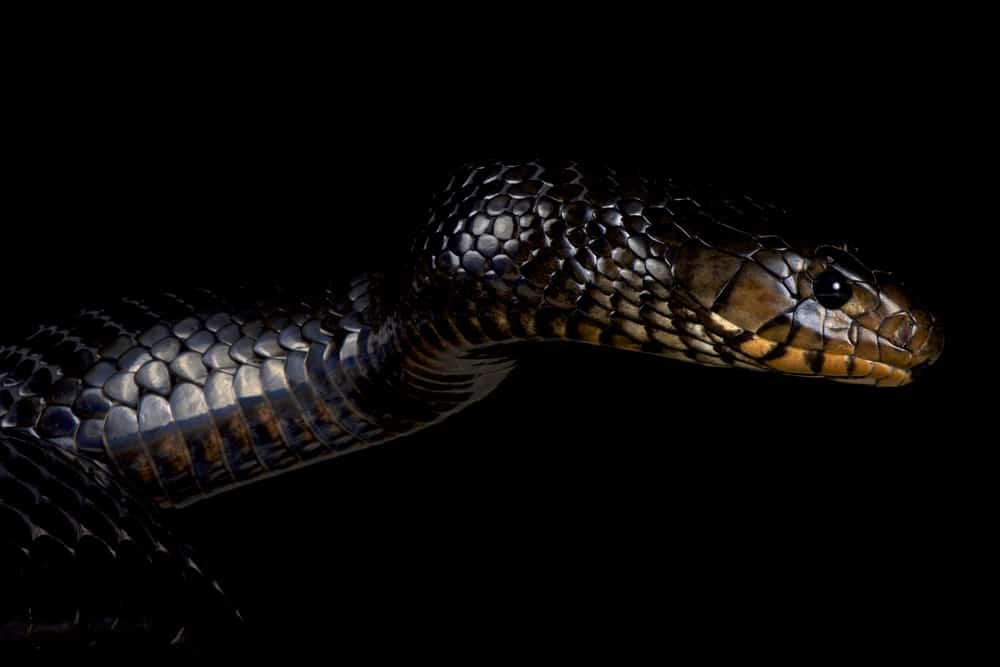
Some landowners like it when Texas indigo snakes are around. These south Texas snakes are known for eating venomous species.
Snake Safety
About Venomous Snakes
Venomous snakes bite around 7,000 people in the US per year. Only 0.2% are fatal.
An average of 1-2 people die from snake bites in Texas a year.
While venomous bites are rarely fatal, they should be taken seriously and require professional medical care.
Even with antivenom, snakebite victims can be left with permanent damage.
Venomous snakes can bite without injecting any venom. These are called ‘dry bites.’
The best course of action is to be cautious and leave wild snakes alone.
Don’t handle dead snakes. Even after death, snakes still have venom.
Walking in Potential Snake Habitats
Whether you’re going for a hike, working in your yard, or out fishing, there are several precautions you should take to keep yourself, your pets, and wildlife safe.
Common snake homes include:
- Logs
- Swamps
- Marshes
- Burrows
- Tall grass
- Rocky areas
While in potential snake habitats, you should wear long pants with sturdy boots that cover your ankles. It’s best not to put your hands anywhere where you can’t see them.
Most importantly, watch your step. Use a stick to move long grass or brush aside when you’re walking through denser areas.
Keep pets on a leash and watch where they put their noses.
Try to stay on well-worn paths.
If You Encounter a Snake
If you see a snake in the wild, admire it from a distance.
Remember to stay calm and don’t try handling it.
Snakes are generally shy creatures. They won’t attack or chase you.
When provoked, they may exhibit defensive behaviors like rattling/shaking their tails, flattening their heads, or assuming an S-position.
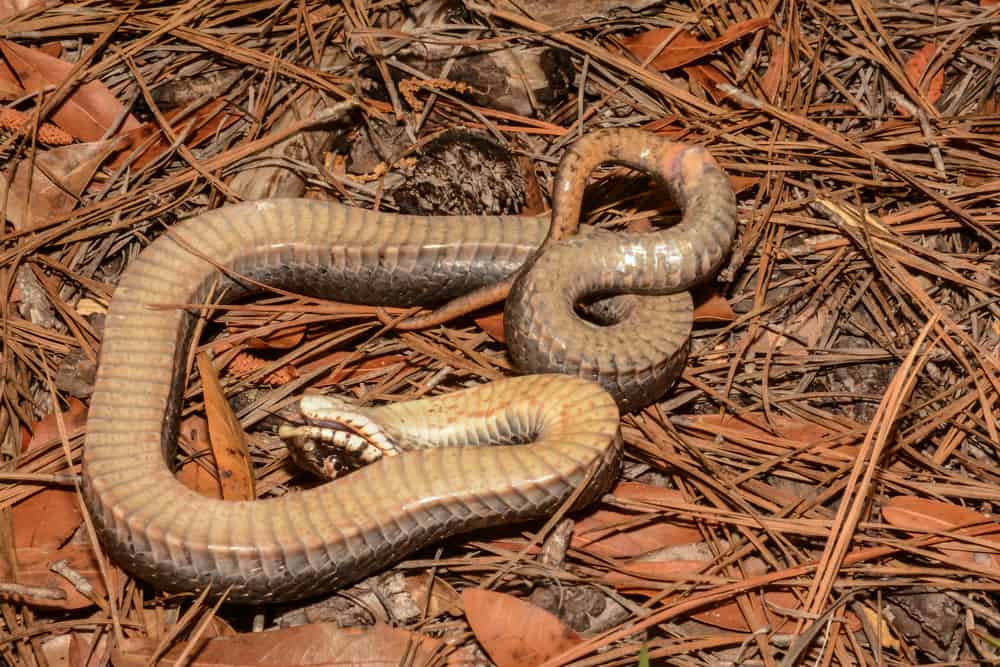
These displays happen because they’re afraid of you and feel the need to protect themselves.
Remember that most snake bites occur when trying to handle the snake.
Enjoy the opportunity to see incredible wildlife and let it go on its way.
When to Call for Help
The best solution for unwanted or potentially dangerous animals on your property is to call a professional.
Your local animal control or licensed wildlife trappers will assist you in removing snakes from your home.
Please don’t try to kill or relocate a snake on your own.
Remember that snakes are an integral part of our ecosystem and don’t want to harm you.
If a venomous snake bites you:
- Stay calm and move as little as possible.
- Call 911 or get the victim to a hospital as soon as possible.
- Remove any tight clothing or jewelry before swelling occurs.
- Don’t attempt any treatment yourself. Wait for a professional.
- Raise the bite above heart level to slow the distribution of venom.
- Remember as many details about the snake as you can. Take a picture of the snake if possible. A proper ID is essential for receiving the correct antivenom.
Call the Texas Poison Center Network for medical centers that treat snake bites.
If a snake bites your pet, seek immediate veterinary attention. Most bites aren’t fatal if treated quickly.
The ASPCA Animal Poison Control Center will provide you with advice and more information on pet bites.
You can find the numbers for these services in our “useful resources” section.
Useful Resources
Texas Poison Center Network: 1-800-222-1222
ASPCA Animal Poison Control Center: 1-888-426-4435.
Visit this Facebook group for a free snake relocation directory.
We hope you enjoyed this guide on Texas snake identification.
Curious about snake species in other states? Check out our Florida, North Carolina, Alabama, Missouri, Georgia, Virginia, Michigan, Tennessee snake identification guides.
Check out our list of the best reptile books for our favorite field guides and more.
